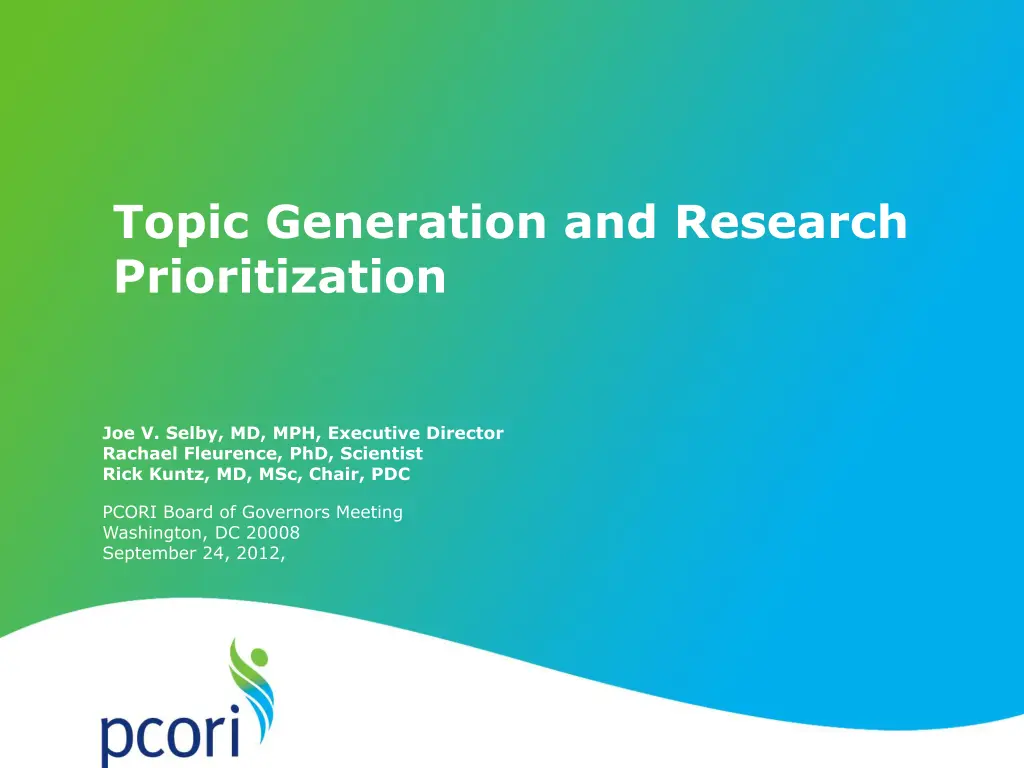
Approaches for Developing PCORI's Research Agenda
Explore the strategic questions and priority areas for the Patient-Centered Outcomes Research Institute's (PCORI) research agenda. Learn about the engagement of patients and stakeholders, transparent processes, and diverse research portfolio. Discover how investigator-generated research and patient/stakeholder-led approaches contribute to developing PCORI's national research agenda.
Download Presentation

Please find below an Image/Link to download the presentation.
The content on the website is provided AS IS for your information and personal use only. It may not be sold, licensed, or shared on other websites without obtaining consent from the author. If you encounter any issues during the download, it is possible that the publisher has removed the file from their server.
You are allowed to download the files provided on this website for personal or commercial use, subject to the condition that they are used lawfully. All files are the property of their respective owners.
The content on the website is provided AS IS for your information and personal use only. It may not be sold, licensed, or shared on other websites without obtaining consent from the author.
E N D
Presentation Transcript
Topic Generation and Research Prioritization Joe V. Selby, MD, MPH, Executive Director Rachael Fleurence, PhD, Scientist Rick Kuntz, MD, MSc, Chair, PDC PCORI Board of Governors Meeting Washington, DC 20008 September 24, 2012,
Strategic Questions to Consider Strategic questions to consider Does the research prioritization process engage patients and stakeholders at the appropriate level? Is the process transparent and rigorous? Will the process enable PCORI to develop a balanced portfolio in line with its mission? Does the process enable the optimal level of engagement between the Board of Governors and Advisory Panels? 2
PCORIs Research Agenda Five Board-Approved Priority Areas 1. 2. Addressing Disparities Communication and Dissemination Assessment of Prevention, Diagnosis, and Treatment Options Improving Healthcare Systems Infrastructure and Methods 3. 4. 5. 3
2 Complementary Approaches for Developing PCORI s National Research Agenda Investigator-Generated Research Just One Part of the Process PCORI issues broad funding announcements Researchers partner with stakeholders to generate questions Researchers, stakeholders apply review criteria in their applications Peer review prioritizes applications by level of alignment with criteria Diverse Research Portfolio answering key questions for patients and clinicians 4
Patient/Stakeholder-Led Approach Unique to PCORI Patient/Stakeholder-Led Approach PCORI and stakeholders generate and prioritize questions based on review criteria PCORI issues specific, funding announcements for highest priority topics Researchers and stakeholders develop responsive proposals Peer review prioritizes applications by level of alignment with criteria Diverse Research Portfolio answering key questions for patients and clinicians 5
Building on the Existing Evidence Base and Prior Experience Existing Scientific Work and Literature Methodology Committee and Methodology Report Experience of Other Agencies 6
PCORIs Process Transparent, Rigorous Final Selection for Specific PFAs (PCORI Board) Topic Generation (Through Multiple Modes) Gap Research Prioritization Confirmation Patients & Stakeholders: Web Page Social Media Workshops PCORI: Continuous Portfolio Review Other agencies: AHRQ gaps NIH gaps Research Opportunities 7
Phase 1: Topic Generation Topic PCORI Filter All Nominated Topics Must: Nomination Process Begins with Patients and Stakeholders Web page Social media/marketing In-person workshops, focus groups Topic generation discussed at Patient and Stakeholder Workshops in the Fall Answer a clinical question around a health care decision Be comparative Not be related to cost/cost effectiveness Align with at least one of PCORI s National Priorities for Research Gap Confirmation AHRQ: Future Research Needs (FRNs) Reports, Systematic Gap Review Other guidelines development processes (such as NQF) Gaps identified by NIH, other funding agencies Building on existing work or other organizations, prioritization exercises (eg, IOM 100) 8
Phase 2: Gap Confirmation Topics Provided to AHRQ for Gap Confirmation Potential Determinations Next Steps Evidence Synthesis Needed Research Prioritization New Primary Research Needed AHRQ Topic Review and Disposition Answer already known, or research underway Dissemination In collaboration with AHRQ; contract under development 10
Phase 3: Research Prioritization Advisory Panels Patients and Stakeholders Board of Governors Prevention, Diagnosis, Treatment Options Research Questions Needing Prioritization Prioritized List of Topics Selected From Prioritized List Creation of PFAs Communication and Dissemination 1. 2. 3. 4. 5. 6. 7. 8. 9. 10. D D D D D D D D D d 11. 12. 13. 14. 15. 16. 17. 18. 19. 20. D D D D D D D D D d Research Prioritization Process Using PCORI Criteria Disparities Improving Health Care Systems Infrastructure and Methods Rare Diseases 11
Five Prioritization Criteria Adapted From PCORI Funding Criteria Patient centeredness 1 Impact of the condition on the health of individuals and populations (prevalence, incidence, and other measures of burden of disease) Potential for improvement: Are the differences in benefits between the interventions sufficient to warrant conducting a research study? Will the study reduce the uncertainty around the effect of the interventions? How likely are the findings to change practice? How long will the information be valid? 2 3 Potential for impact on health care performance 4 Potential for inclusiveness of different populations 5 12
Developing Topic Briefs for Prioritization of Questions Sample PCORI Topic Brief Each Topic Brief explores a research question for which a gap has been identified Topic Brief addresses PCORI s criteria: patient centeredness, impact of disease, potential for improvement, etc. 13
Piloting the Process with Patients and Stakeholders Patients and stakeholders will participate in a pilot prioritization exercise using topic briefs and online tools. Participation will be by open application. 1 The pilot group will convene via several teleconferences to discuss topic briefs and results of initial ranking exercises. The pilot group will meet in person to reach consensus on a final prioritized list, and to provide feedback to PCORI. The group will present at the December 5th workshop. 2 3 The revised process will be used by Advisory Panels in Winter 2013 with topics generated from patients and stakeholders across the country. 4 14
Research Prioritization Timeline Aug Sep Oct Nov Dec Jan Feb Mar PCORI Science Team proposes initial RP Process Technical Working Group tests/provides feedback on RP Process; supports development of PCORI RP Process Patients, Stakeholders pilot RP process Revised Prioritization Process presented at PCORI Methods Workshop December 5th Patient/Stakeholder Advisory Panel training on Research Prioritization Methods Advisory Panels conduct Research Prioritization Process for nominated topics and submit to the Board 15
PCORIs Research Prioritization Team PCORI Staff and Leadership: Joe Selby, Executive Director Rachael Fleurence, Scientist Katie Wilson, Project Management Natalie Wegener, Project Coordination Technical Working Group: Arnie Epstein (BoG) Gail Hunt (BoG) Neil Kirschner (Stakeholder Representative) David Meltzer (Methodology Committee) Linda Morgan, RPh, MBA (Patient Representative) Jean Slutsky (Methodology Committee) Clyde Yancy (Methodology Committee) Pilot Workshop Participants: Approximately 15-20 patients, stakeholders, researchers, and experts trained and prepared in PCORI s research prioritization process 16
Summarizing PCORIs Unique Approach Research Prioritization to Patients and stakeholders engaged in each step of a transparent process: Patients and stakeholders involved in developing the process, providing feedback, and members of the future Advisory Panels PCORI criteria for research prioritization: Criteria developed to achieve research that will improve patient s health outcomes, is impactful, and has a high probability of changing clinical practice Transparency/visibility embedded in the process: Process shared with public for input and comment Pilot group open to applications Research prioritization methods workshop on December 5th broadcast via Web cast 17
Revisiting the Strategic Questions Does the research prioritization process engage patients and stakeholders at the appropriate level? Is the process transparent and rigorous? Will the process enable PCORI to develop a balanced portfolio in line with its mission? Does the process enable the optimal level of engagement between the Board of Governors and Advisory Panels? 18



















